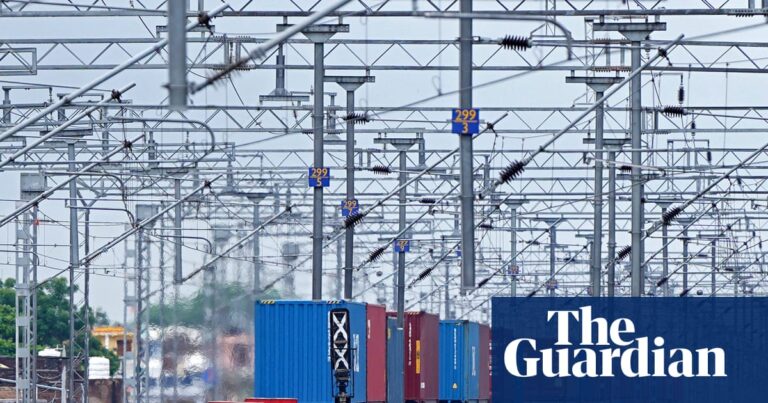Donald Trump’s tariffs of 50% have come into force on most US imports from India. The US president followed through on his threat to punish one of the world’s largest economies for its purchases of discounted Russian oil.
What might the impact be on India’s economy?
Washington added an extra 25% duty on top of the 25% imposed earlier this month, citing India’s refusal to stop buying Russian crude and defence hardware.
The duties, which are 16 percentage points higher than China, 31 points higher than most south-east Asian countries and 35 points above South Korea, have pushed US tariffs on Indian goods to levels that the investment house Nomura likened to a “trade embargo”.
The US is India’s largest export market, worth $86.5bn (£64.1bn) a year. Around two-thirds of shipments are covered by the 50% tariff, threatening jobs and growth across sectors reliant on US demand.
“No Indian product can stand any competitive edge under such heavy import taxes,” said Garima Kapoor of Elara Securities. Economists say the tariffs could erase up to one percentage point from India’s GDP growth this fiscal year.
Unemployment is a worry. India’s overall jobless rate stood at 5.6% in June, rising to 7.1% in cities. A major drop in US exports could hit millions of workers, economists say.
Where will the biggest impact be felt?
India’s giant generic pharmaceuticals sector and its electronics and petroleum products are exempt from the tariffs. Aluminium, steel and copper remain at 25%, but job-heavy sectors such as textiles, jewellery, seafood and leather are squarely in the line of fire.
Exports from affected sectors could plunge 70%, from $60.2bn to $18.6bn, while overall shipments to the US could fall by 43%, said Ajay Srivastava, a former Indian trade official and founder of the Global Trade Research Initiative, Delhi-based thinktank .
Companies rushed shipments ahead of the 27 August cut-off. With the tariff wall now up, exporters must either swallow costs, which will be impossible for many, or cede market share to countries such as Vietnam, Bangladesh and Mexico.
India’s $179bn textiles industry includes $37.7bn in exports, with the US buying nearly $10.3bn. Mithileshwar Thakur, of the Apparel Export Promotion Council (AEPC), said Indian exporters now faced a 30% cost disadvantage compared with Bangladesh, Vietnam and Cambodia. “This is an earthquake,” said Kirit Bhansali, chair of the Gems and Jewellery Export Promotion Council.
Even if tariffs are lowered later, competitors may have already locked in US market share. “Competitors like China, Vietnam, Mexico, Turkey, and even Pakistan, Nepal, Guatemala and Kenya stand to gain, potentially locking India out of key markets even after tariffs are rolled back,” Srivastava said.
Can India wean itself off Russian oil?
India, the world’s third-largest oil consumer and top buyer of Russian seaborne crude, could wean itself off Russian oil over time. But right now it views Russia as an all-weather friend – a vital defence and energy ally amid the trade turmoil that Trump has unleashed. Russia supplies about 40% of India’s oil needs, up from less than 1% before the Ukraine war. Even though discounts on Russian crude have narrowed from $20–$25 below benchmark Brent crude in 2022 to about $2.50 a barrel now, India continues buying because it secures energy reliably and relatively cheaply.
A sudden reduction could also leave India vulnerable to global price swings. It will continue buying oil from wherever it gets the best deal and take measures to protect its national interest from US tariffs, India’s ambassador to Russia, Vinay Kumar, told TASS onsaid at the weekend. He also said India was able to pay for Russian oil in rupees, which meant it didn’t have to use its US currency reserves. “Now, we have a working system of trade settlement in national currencies. There is no problem now in payment for oil imports,” he said.
Indian firms are calculated to have saved $17bn by buying cheaper Russian oil since the start of the war in Ukraine, but that could be dwarfed by the impact of tariffs on exporters, which could cut India’s US exports by nearly $37bn this financial year, said Srivastava.
What is India doing to mitigate the impact?
Narendra Modi’s government has urged Indians to buy domestically made goods. “I appeal to the citizens of our country to prioritise purchasing goods that are made in India,” the prime minister said this week. The government also plans to shake up the nationwide goods and services tax, cutting most rates to 5% or 18% to boost spending.
Essentials such as food, textiles and cement will become cheaper, while luxury goods remain pricey. The government is reportedly assembling a multibillion-dollar package to free up cash for exporters.
India has been seeking to diversify its markets and recently signed a free trade deal with the UK. But exporters say much more is needed. The Federation of Indian Export Organisations (FIEO) has called for a state-supported one-year moratorium on repaying the principal and interest on loans to free up cash for diversifying markets. “We are staring at a crisis which will force shutdowns and cause unemployment,” said the FIEO’s president, SC Ralha. The AEPC has appealed for interest relief to counter high borrowing costs of between 8% and 12%, compared with 3% in China and Malaysia.
India is also cautiously warming up to Chinese investment as part of a strategic pivot in response to escalating US tariffs. Modi is making his first visit to China since relations went into a deep freeze following a brutal clash along their disputed border in 2020 to attend the Shanghai Cooperation Organisation summit.
He said this week the world was living through an era of “economic selfishness” in which countries pursue their own interests first. “No matter how high the pressure, India will continue to build its strength to withstand it,” he added. “India is ready to pay a very heavy price to protect its interests.”
